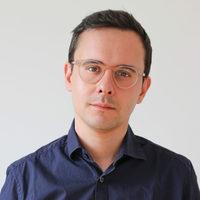Riccardo M Villa
Tu Wien, Architecture Theory, Faculty Member
An anthology of essays that revolve around a cloud of topics concerning the architectural profession – from the notions of immaterial production and creative work at large to the ethics of the profession and the labour conditions in... more
An anthology of essays that revolve around a cloud of topics concerning the architectural profession – from the notions of immaterial production and creative work at large to the ethics of the profession and the labour conditions in architectural practice – The Architect as a Worker includes contributions from practitioners, scholars, theorists and sociologists outside of the architectural milieu, critics and activists. The wide spectrum of themes raised and the many ways they are approached ..
According to Hans Blumenberg, Weltbildverlust is the distinctive trait of the Modern Age. World-images are lost and forgotten due to the rise of scientific and operative world-models. This understanding of science reconnects with the... more
According to Hans Blumenberg, Weltbildverlust is the distinctive trait of the Modern Age. World-images are lost and forgotten due to the rise of scientific and operative world-models. This understanding of science reconnects with the ancient project of philosophy: to emancipate knowledge from images—something that the philosophical tradition, from Plato onwards, has always looked with deference and as potentially treacherous. Digital technology seems to fulfil this dream: it turns knowledge into a numeric matter, computable and non-figurative. This is the character of what Jean-François Lyotard named as the postmodern condition. And yet, today we find ourselves drowning in pictures, as portable devices push to an even more capillary diffusion—in space and in time—of the "spectacle" of society. The emancipation of images turns into its opposite: with the digital everything is image. In a computerised society knowledge becomes a matter of production and consumption, handing ...
Research Interests:
Research Interests:
Besides their differences, Hilberseimer´s vision of the metropolis and Wright´s organic architecture seem both to respond to the loss of a clear urban figure; in their designs the project of the city shifts from a total planning to the... more
Besides their differences, Hilberseimer´s vision of the metropolis and Wright´s organic architecture seem both to respond to the loss of a clear urban figure; in their designs the project of the city shifts from a total planning to the conception of its organic `cell´. The city is re-invented as a milieu, a metabolic space of flows and transformations that goes along with a novel way of government, described by Foucault as `bio-power´
Research Interests:
Research Interests:
Research Interests:
Since the Renaissance, perspective drawing has been established as the most ‘objective’ way to represent a ‘subjective’ point of view; it is precisely through the reflective surface of a mirror, as the space in which the self can be... more
Since the Renaissance, perspective drawing has been established as the most ‘objective’ way to represent a ‘subjective’ point of view; it is precisely through the reflective surface of a mirror, as the space in which the self can be objectified, that such invention takes place. The apparent contradiction of an ‘objective subjectivity’—which most of modern science builds upon—can be properly investigated only if such space of ‘speculation’ is addressed as an excluded, invisible element of a triadic setting. The paper will then try to look at modern ‘rationality’ as a ‘projection’ arising from such exclusion and externalisation—to inspect the space of the mirror as an architectonics of information. It will do so by looking at a range of examples—from architecture to philosophy, art and literature—in which this third is consciously questioned, or where it is instead ‘invisibly’ at work. The outline of such a “transcendental topology” will then perhaps provide the tools to address in a ...
Research Interests: Medieval Philosophy, Architecture, Renaissance, Carl Schmitt, Albert the Great, and 12 moreAverroes, History of architecture, Ibn Rushd (Averroës), Speculation, Renaissance Archicteture, Perspective, Postdigital, History of Architecture, Masaccio, Digital Architectonics, Filippo Brunelleschi, and Contour
Contributions to the "Milan Architectural Guide 1945–2015", edited by F. Andreola, M. Biraghi and G. Lo Ricco (Hoepli, 2015).
Research Interests:
Research Interests:
If modernity was supposed to be the age in which world-images were abrogated or discredited as world-views, or as ideologies to be critiqued and deconstructed, our contemporary condition seems to be faced with an unexpected reappearance... more
If modernity was supposed to be the age in which world-images were abrogated or discredited as world-views, or as ideologies to be critiqued and deconstructed, our contemporary condition seems to be faced with an unexpected reappearance of images and of their importance for orienting our values. Instead of coming from mythology, theology or philosophy, these "world-pictures" are rather 'renderings' and 'accounts' of scientific models; by conceiving and studying their subject as a closed environment-as an oikos, a 'house'-disciplines like economy and ecology are able to project their own picture of the world. Yet, such pictures become normative (they acquire the power to legitimate policies) only when they are pushed to their own limit; in other words, these pictures become images whenever they stage the crisis of their own model. But is this phenomena limited to the contemporary condition and to its presumedly singular 'criticality', or is i...
